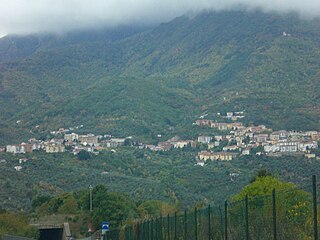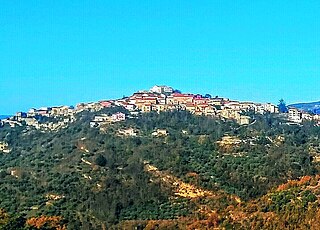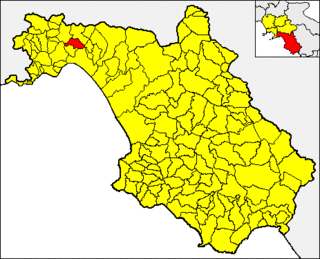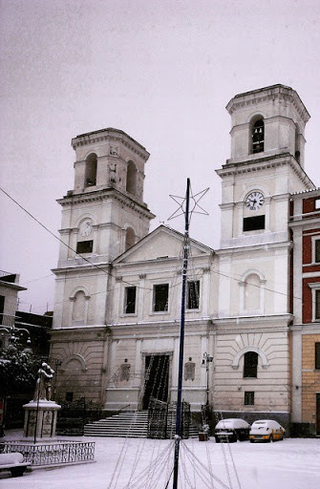
Philomena, also known as Saint Philomena or Philomena of Rome was a virgin martyr whose remains were discovered on May 24–25, 1802, in the Catacomb of Priscilla. Three tiles enclosing the tomb bore an inscription, Pax Tecum Filumena, that was taken to indicate that her name was Filumena, the English form of which is Philomena. Philomena is the patron saint of infants, babies, and youth, and is known as "The Wonderworker".
Santo Stefano is the Italian name of Saint Stephen.

The province of Avellino is a province in the Campania region of Italy. Its capital is the city of Avellino. The area is characterized by numerous small towns and villages scattered across the province; only two towns have a population over 20,000.

Massa Martana is an ancient Italian town and comune in the Monti Martani mountain range in the province of Perugia (Umbria). It is 10 km N of Acquasparta, 18 km N of San Gemini and 32 km N of Narni; 14 km S of Bastardo and 27 km S of Bevagna. As of the 2003 census, the town had 3558 inhabitants.

Circumvesuviana is a railway network in the east of the Naples metropolitan area, previously run by a company of the same name, now operated by Ente Autonomo Volturno. Electrically powered throughout, the system uses the narrow gauge of 950 mm and operates 142 km (88 mi) of route on six lines. It is entirely separate from other national and regional railway lines. It has 96 stations with an average interstation distance of 1.5 km (0.9 mi).

Gesualdo is an Italian town in the province of Avellino, itself in the region of Campania. It is called "The city of the Prince of Musicians" in honour of Carlo Gesualdo. It has many palaces, fountains, belvederes, and a historical center, which was partially restored after the Irpinia earthquake in 1980.

Atripalda is a town and comune in the province of Avellino, Campania, southern Italy.

Calabritto is an Italian town and a commune in the province of Avellino, Campania, Italy. It occupies a hilly-mountainous area at the eastern tip of the Monti Picentini range, in the upper Sele valley.

Mercogliano is an Italian town and comune in the province of Avellino, Campania, southern Italy.

Montecalvo Irpino is a town and comune in the province of Avellino, Campania, southern Italy.
Mugnano del Cardinale is a town and comune of the province of Avellino in the Campania region of southern Italy.
Taurano is a village and comune in the province of Avellino, in the Campania region of southern Italy.
Sperone is a town and comune in the province of Avellino, in the Campania region of southern Italy.

Baronissi is a town and comune in the province of Salerno in the Campania region of south-western Italy. It is home to a campus of the University of Salerno.
Pannarano is a comune (municipality) in the Province of Benevento in the Italian region Campania, located about 45 kilometres (28 mi) northeast of Naples and about 15 kilometres (9.3 mi) southwest of Benevento. As of 1 January 2020, it had a population of 2,077 and an area of 11.73 square kilometres (4.53 sq mi).

Sant'Arcangelo Trimonte is a comune (municipality) in the Province of Benevento in the Italian region Campania, located about 70 km northeast of Naples and about 13 km east of Benevento.
Visciano is a municipality, that is on the edge of the Metropolitan City of Naples, on the border with the province of Avellino in Campania. As of 31 December 2004, it had a population of 4,607 and an area of 10.9 km2.
Mugnano may refer to some places in Italy:

Naples Metropolitan Railway service are two independent companies that operate a commuter rail system in Naples. The first one, Trenitalia, operates line 2 from Pozzuoli Solfatara to Gianturco station in East of Naples. The other one, EAV, operates the Circumvesuviana, Cumana, Circumflegrea and MetroCampania NordEst. In Italy, Naples is the only city possessing two independent metropolitan railway service companies.

The Sanctuary of Saint Philomena is the main Catholic place of worship in Mugnano del Cardinale, in the province of Avellino. Inside, the remains of Saint Philomena have been kept since August 10, 1805. It is one of the nine sanctuaries of the Diocese of Nola.

















